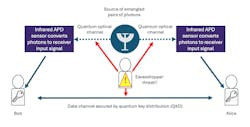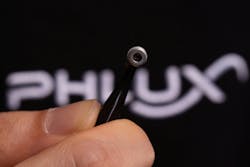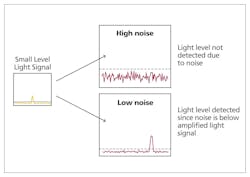Quantum key distribution: Secure optical communications
In the ever-evolving landscape of cybersecurity, quantum key distribution (QKD) promises unbreakable encryption for optical communications. This cutting-edge technology harnesses the enigmatic principles of quantum mechanics to create a fortress around our most sensitive data. As we delve into the world of QKD, we'll explore its purpose, inner workings, and the crucial role of infrared sensors for the quantum revolution.
Role of cryptographic keys
Cryptographic keys—typically strings of random numbers and letters—play a pivotal role in modern information security (see Fig. 1). They enable secure data exchange in various contexts, including cryptographic infrastructures, data center security, and the protection of sensitive information for sectors like healthcare and finance. Crypto keys are crucial for safeguarding critical infrastructure systems such as smart grids and national defense communications. Beyond this, advanced key distribution methods facilitate long-distance secure communication, with innovations paving the way for global secure networks.
Specialized applications are emerging for diverse fields, from securing genome data transmission to protecting high-value intellectual property for industries like aerospace and pharmaceuticals. Research and development efforts are also adapting key distribution techniques for mobile and dynamic networks to enhance communication security for scenarios such as ship-to-ship interactions and autonomous vehicle coordination. While some organizations have reservations about certain key distribution methods for national security applications, ongoing advancements aim to address these challenges.
Quantum advantage
At its core, QKD addresses a fundamental vulnerability of traditional cryptography: the key exchange process. As computational power surges forward and the specter of quantum computers looms on the horizon, conventional methods of key distribution are increasingly at risk. QKD offers a paradigm shift by basing its security not on mathematical complexity, but on the immutable laws of physics.
The beauty of QKD is its elegant simplicity. Individual photons, the fundamental particles of light, are encoded with quantum states representing bits of a cryptographic key. These photons are then transmitted over an optical fiber link to create a secure channel between two parties. The quantum nature of these photons ensures that any attempt to intercept or measure them inevitably disturbs their delicate state—immediately alerting the communicating parties to the presence of an eavesdropper.
Infrared sensors: The eyes of quantum communication
Within the realm of QKD, infrared (IR) sensors serve as the vigilant sentinels—ever watchful for the arrival of these quantum messengers. Most QKD systems operate within the IR spectrum, typically at wavelengths around 1550 nm, which align with the low-loss windows of optical fibers (see Fig. 2).
The sensitivity of these IR sensors is paramount and directly impacts the performance and capabilities of QKD systems. High sensitivity allows for the detection of weaker signals, which is a crucial factor because of the inherently faint nature of quantum signals. This enhanced sensitivity translates into tangible benefits: increased maximum transmission distances, higher key generation rates, and improved tolerance to channel losses and noise.
As researchers push the boundaries of IR sensor technology, the horizons of QKD expand and bring us closer to a world where quantum-secure communication is the norm rather than the exception.
Avalanche photodiodes: Amplifying the quantum whisper
Avalanche photodiodes (APDs), IR sensors capable of detecting single photons, are at the heart of many QKD systems. These devices operate on the principle of the avalanche effect, where a lone incident photon triggers a cascade of electron-hole pairs and amplifies the signal to a measurable current.
The choice of APDs for QKD is no coincidence. Their sensitivity allows them to discern the faintest of light signals down to an individual photon. This is coupled with rapid response times, which enables the high-speed key generation crucial for practical applications. Moreover, when properly cooled, APDs exhibit impressively low noise levels and maintain the low error rates essential for reliable quantum communication.
Advancing QKD with improved APD technology
Recent advancements in APD technology have the potential to significantly enhance QKD systems. For instance, the Phlux Aura APD, based on noiseless indium gallium arsenide (InGaAs) technology (see Fig. 3), offers improved performance over traditional InGaAs APDs. These sensors provide as much as 12x higher sensitivity and can operate with APD gains up to 120, which enables detection of even the smallest signals above the noise floor (see Fig. 4).
For QKD applications, this enhanced sensitivity could translate to several benefits. The increased detection efficiency allows for longer transmission distances and potentially extends the range of QKD networks. Higher sensitivity also means that weaker quantum signals can be reliably detected, which could lead to improved key generation rates and better tolerance to channel losses. And the ability to operate at higher temperatures without performance degradation could simplify the thermal management requirements of QKD systems.
QKD use case: The Marconi project
As we stand on the cusp of a quantum communication revolution, initiatives like Innovate U.K.’s Marconi project are leading the charge in translating theoretical promise into practical reality. Named after the visionary radio engineer Guglielmo Marconi, the Marconi project is a collaborative research initiative aimed at advancing quantum communication technologies, particularly in the realm of satellite-based quantum key distribution.
The Marconi project brings together experts from academia, industry, and government agencies to tackle the challenges of implementing QKD on a global scale. The project’s goals include developing more efficient QKD protocols, creating robust quantum communication satellites, and establishing international standards for quantum-safe cryptography.
As the Marconi project and others like it continue to push the boundaries of what’s possible, we edge closer to a future where quantum-secured communications are not just a possibility but a ubiquitous reality. In this quantum-safe future, our most sensitive data will be protected by the fundamental laws of nature and usher in a new era of information security in our increasingly connected world.
About the Author
Ye Cao
Ye Cao is an application engineer at Phlux Technology, a manufacturer of high-sensitivity avalanche photodiodes (APDs) for infrared (IR) sensing applications. He earned a Ph.D. from the University of Sheffield in IR APDs.



